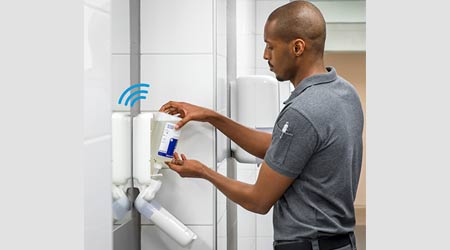« Back to Facilities Management Plumbing & Restrooms Category Home
Building Internet of Things Can Simplify Restroom Management
May 17, 2016
- Plumbing & Restrooms

by Jimy Baynum
From office buildings to educational facilities and everything in between, there’s one area that all are sure to visit – the restroom. While it is may not be the most glamorous facility, the experience that people have in this space impacts their overall impression of the building and the business that inhabits it. By creating a premium, clean, and streamlined environment, facility managers can help improve visitors’ experiences and impressions.
Nowadays, technology is transforming the way that facility managers tackle restroom upkeep. Historically, facility staff and cleaning teams carried out tasks such as restocking bath tissue, refilling soap dispensers, and managing supply orders through room-to-room checks. These processes consume valuable time. But now, thanks to the Building Internet of Things (IoT), facility managers can leverages sensors embedded in objects to collect and exchange data around the clock.
High-quality service is intricately linked to resolving issues immediately after – if not before – they arise. That’s why smart restroom solutions such as Tork EasyCube, which uses web-enabled sensors embedded in hand-towel, bath-tissue, and soap dispensers to wirelessly transmit refill needs to a web application, can be an invaluable partner. By capturing this information, data not only assists facility managers with managing everyday responsibilities, but also cuts down on laborious tasks. There are four advantages to incorporating this into a building’s business model:
• Improving Staffing: By tracking washroom usage through accurate monitoring, facility managers are better informed when making staffing decisions. Because IoT technology produces actionable data that transitions cleaning staff from a schedule-based cleaning approach towards a more efficient, needs-based method, the number of necessary employees per shift can vary dramatically based on facility traffic. By having this information in hand, facility managers can better manage staff and anticipate needs.
• Enhancing Restroom Experiences: Intelligent restrooms let facility managers know how many people have visited each restroom at a glance and can guide them in determining how staff should best be deployed to address issues before complaints arise. Because facility staff is responsible for a range of tasks, many of which are more urgent than tackling restroom product refill complaints, by minimizing the number of times they hear about a lack of bath tissue or soap, their day goes much more smoothly.
• Increasing Ordering Accuracy: Data captured from smart washrooms helps facility managers better understand product consumption patterns that dictate the volume and frequency of new orders. Because facilities often have limited product storage space, knowing the rate at which products are used can help staff avoid ordering more product than their storage areas can accommodate, eliminating unnecessary headaches.
• Building Envy: Fully-stocked and consistently clean restrooms make a great impression. When tenants and visitors have seamless experiences in a building, it can generate positive word of mouth for that venue, improving overall reputation as well as increasing tenant recommendations. Thus, not only can technology improve the efficiency of maintaining building washrooms, it can also wow first-time visitors and long-term tenants alike.
IoT technology uses are endless and provide numerous benefits to staff and building management. By understanding its benefits and identifying areas where real-time data can improve processes and reputation, building managers can catapult their business from the industrial age into the digital age – all while simplifying their daily life.
Jimy Baynum is director of market development at SCA - AfH Professional Hygiene Business.








